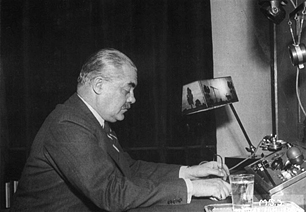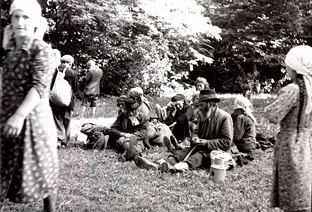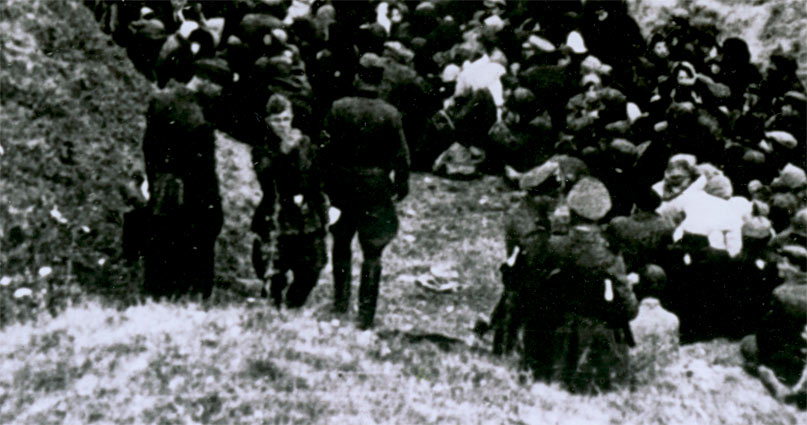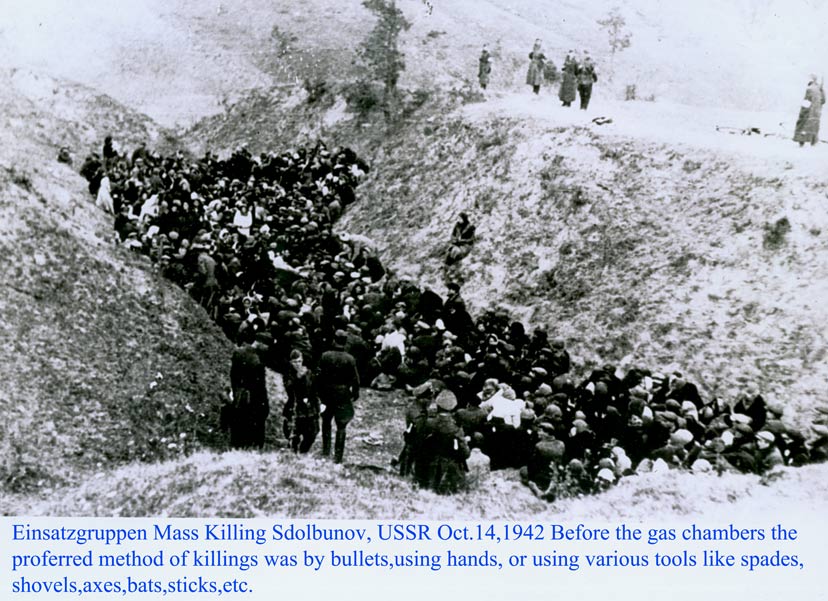|
To go back to Page One of Memorial Click This Link
Here
Details On Kamenets-Podolsk Massacre Here then is a more detailed report of the Kamenets-Podolsk Massacre which took place in late August-Early September 1941. The Hungarian Goverment manages to put in a law that states that Jews who could not prove their citizenship will be deported to the Ukraine.It was hard to prove this because many of these places had changed hands at least twice and the law states you must prove you had lived in this region before 1914.It was done this way purposely in order to make sure the most Jews could be kicked out to the Ukraine. Jews in Carpathia are crammed into freight cars similar to the cattle cars used for concentration camp transports.They then journeyed to Korosmezo which took around 24-48 hours.At Korosmezo the Jews are transfered to the Germans at the rate of about 1,000 per day.By August 10TH about 14,000 had been processed and by the end of the month an additional 4,000. From Korosmezo the Jews were handed over to S.S. Units who put them into trucks and drove them to Kolomea (kolomyya).They wre then marched in groups of 300-400 to temporary housing around Kamenets-Podolsk.Along the way most were assaulted and robbed of any valuables by the S.S. and their Ukrainian Henchmen.Those who refused to do this were beaten and probably killed on the way. Becuase the local Jews were mostly women and children and because of the economic situation these Jews could not cope with the prospect of having to feed all these refugee Jews.This task would have to fall on the Germans so the Germans now told the Hungarians to halt the transports and after that they also tried to "repatriate" the Jews back to Hungary.The Hungarians refused to either feed or "repatriate" these Jews so the Germans held a conference on 8/25/41.The conference was held at the Nazi Headquaters Generalquatiermeister-OKH in Vinnitsa,Ukraine.It was headed by S.S.Major Wagner.S.S.Obergruppenfuhrer Franz Jaekeln,the higher S.S. and Police Leader gave the assurance that all these Jews would be liquidated by Sept.1,1941. The liquidation of the Jews at Kamenets-Podolsk began on Aug.27,1941.From an eyewitness report we learn the gruesome facts.The Jews are told they are to be relocated and that Kamenets-Podolsk would be cleared of all Jews.Surrounded by units of S.S.,their Ukrainian hirelings,and most probably a Hungarian Army Unit.The Jews are forced to march 10 miles untile they reached an area filled with bomb craters.There they are forced to undress and murcered by machine guns.Many are buried alive being gravely wounded and not yet dead..It is now estimated that at least 16,000 Jews from Hungary are killed and the total amount is over 23,000. There were soldiers in the Hungarian Army who halted the Actions and also were very angry at this event.the proof of this is in letters written home or the talk told during a soldier's furlogh home.Many are upset at the brutal killings by machine gun of unarmed citizens and when the Minister Of The Interior,Kereztes-Fischer, learned of the killings he pushed to have all deprtations stopped.The evidence available shows that the higher ranking (at least some or all) had no idea that by deporting Jews to German Occupied Territories would mean their extinction.It is possible that most of the members of the Hungarian Cabinet had only wanted to expel the Jews not murder them outright.This is the first showing of the "Final Solution" in Hungary.It should also be noted that Keresztes-Fischer tried to be decent towards the Jews and later on he himself would be arrested and sent to the Mauthausen Concentration Camp. NOTE:Around this time Germans would begin to want a "better" solution to kill Jews and undesirables.It appears that the machine gun killings will take a toll on some of the S.S. so soon we will see that Germans will experiment with new ways of mass killing.Mobile Death Vans would be the first approach.Prisoners are put into a van which is sealed and pumps in exhaust fumes till all is dead inside.This will eventually become the Gas Chamber with exhaust fumes and then the Gas Chamber using the infamous Xyclon-B poison gas with Crematorium located next to the Gas Chambers.This is what was built in Auschwitz.And special for all the Hungarian Jews the railway would be extended to drive right up to these Gas Chambers,When the Hungarian Jews arrive in Auschwitz May-June 1944 the killing machine is so efficient it is able to kill and dispense with the bodies of at least 10,000 per day. The same execution and this one zoomed back out.Now you can see there are hundreds waiting to be shot. Additional Information I have found on the Internet on this little known Massacre. Kamenets-Podolsk was occupied by German and Hungarian troops on July 11,
1941. Some Jews succeeding in leaving the city before the arrival of Axis
troops. Soon after the start of the occupation some 60 Jewish men were shot
in the Old Town. The German military authorities appointed a local
administration consisting of Ukrainian ultra-nationalists, who proceeded to
conduct antisemitic propaganda. The First Massacre: Kamenets-PodolskyAs opposed to the European Jewish communities destroyed by the Nazis, the majority of Hungarian Jews were not in life danger until the spring of 1944. Nevertheless, between 1941 and 1944 Hungarian Jewry suffered losses that can be measured in the tens of thousands. The Hungarian government, which stepped onto the path of institutionalised antisemitism by creating consecutive anti-Jewish Laws from 1938, was utterly frustrated by the fact that
The new Hungarian authorities of Carpatho-Ruthenia, which was occupied in 1939, were bothered by more than one element of the presence of the Jews: they outnumbered the Hungarians; a large part of the community consisted of the conservative, religious, orthodox Jews despised by the new rulers; and there were many foreign refugees among them. The thought of deporting the poor, rural Jewry occurred to the government commissioner of Carpatho-Ruthenia, Miklós Kozma, already in the fall of 1940.[1] In the winter of 1940-1941 in the framework of arbitrary "cleaning" actions, Jewish families were driven across the Soviet and Romanian borders at some places by the Hungarian civilian and military authorities.[2] The next spring Hungarian authorities expelled plenty of Serb inhabitants from the re-annexed Délvidék (Southern Provinces), since they considered them hostile. Meanwhile Kozma carried on planning to deport the rural Jews. A possibility for that opened up in the summer when Nazi Germany invaded the Soviet Union. Leaders of the army, the public administration of Carpatho-Ruthenia and some officials of KEOKH supposed that under the chaotic circumstances of war they could deport the unwanted Jews to no man's land. Kozma gained the approval of Prime Minister László Bárdossy, Minister of the Interior Lajos Keresztes-Fischer and also Regent Miklós Horthy. The round-up of the "stateless" Jews (i.e., those who were not holding Hungarian citizenship) and the Jews with "unsettled citizenship" commenced in July. The objective of the action was "to move as soon as possible the largest number of Polish and Russian Jews, who have infiltrated the country lately". According to the explanation, those deported would have stayed under Hungarian control, since Hungarian troops were occupying Galicia. Jews were also promised to obtain the real estates of those Jews who left the territory with the retreating Red Army. This cynical lie was only a cover for looting the victims: Jews deported from Hungary were allowed to take only 30 pengős, food for three days and some personal belongings.[3] Round-up and deportation Hungary and the Soviet Union entered a state of war at the end of June 1941. The round-up of the Jews
Abuse of authority was widespread during the action. Only eight Jewish families lived in Eötvösfalva. All of them were Hungarian citizens, still they were deported. 18-year-old Hanna K. was visiting relatives in the neighbouring village, Taktaharkány. Returning home, she found the Jewish homes vacant. Hanna never heard from her parents or neighbours again. She escaped to her relatives. In 1944 they were deported to Auschwitz together.[6] From Alsószinevér, approximately 300 people were deported-mostly merchants and farmers.[7] Izsák Jakubovics married in Silesia. When the Nazis invaded Poland, he escaped with his family to the Carpatho-Ruthenian village of Majdanka, which he thought was safe. As Polish Jews, they were deported across the border in 1941, but many other Jews from Majdanka-including Hungarian citizens-were dragged off as well.[8] The Hungarian authorities were rounding up Jews not only in Carpatho-Ruthenia, but also in
A majority of those rounded-up was transported to the collection camp set up at the border station of Kőrösmező. As a foreshadowing of the 1944 deportations, cattle cars and truck convoys arrived there and left for Galicia and Ukraine. The first transport left on July 14. In the following weeks 13,400 Jews from Carpatho-Ruthenia and 4000 Jews from the rest of the country were deported across the border. The transports headed northeast, but the destinations were different. Massacre at Kamenets-Podolsky Most of the deportees were taken to Kamenets-Podolsky through Kolomea. With the retreat of the Soviet
The fate of the other deportees Based on the recollections of the survivors, it is clear that only a part of the deportees were taken
For the majority, ordeals started after crossing the border. The unfortunate deportees were at the mercy of not only the Hungarian and German armed forces, but also of the collaborating Ukrainian militia and the local inhabitants: "One time Hungarian, another time German soldiers beat them, elderly people were either shot or thrown into the Dnester River. They shot my mother in front of my brother who managed to come back from death's door." - as the story was told by one of the Schächters, a girl who was the only family member remaining home.[20] Hermann Frimmer, a labour servicemen from Tiszaújváros, witnessed how the Hungarian soldiers heading to the front cruelly treated the Jewish deportees: "A sergeant of Nyíregyháza Jenő Király had 17 people thrown into the Dnester in front of our eyes, people deported from Hungary in 1941. Amongst them there was a married couple I knew."[21] A 17-year-old-boy, arrested in Budapest, was deported with his family: "They crossed the borders with us and then let us free, telling us to go wherever we wanted to. We crossed the Polish border at Kőrösmező, we could not turn back as they would have killed us but could continue in the direction of the centre of the country. In Poland we went into a forest where the SS and Hungarian gendarmes were shooting at us. Unfortunately, I saw how they shot my mother and my brothers and sisters." After that the boy escaped back to Hungary alone.[22] Thousands of deportees managed to get to Stanislawow. The Ukrainian population attacked the Jews already after the Red Army left, but the Hungarian army thwarted the pogrom. The mass killings commenced when at the end of July the Germans took control over the city. This period was remembered by Adlers from Alsóapsa: "The major part of the deported Jews were shot, some were taken into the ghetto of Stanislawow. They threw many into the river Dnester, cut the breasts of women, cut children into two and buried a lot of people alive."[23] Those still alive in March 1943 were sent to the gas chambers of the Belzec extermination camp.[24] The members of the Sachs family arrived at Chortkow, as did many other deportees. In spite of the warnings We were in a horrible state of mind and had no idea what would happen to us ...The day after the people who stayed in barracks (around 4,000 of them) had to start marching on foot. They were chased for 10 days in rain and mud when the Gestapo killed them. Eight of them survived."[25]
The events of the 1941 deportations that took place over the border can be reconstructed from the recollection of those survivors who managed to get back to Hungary. Most of them paid Polish, Hungarian or Ukrainian peasants for help: they showed the way through the passes of the Carpathians, they hid the Jews in their wagons. Many Jews made their way back home in Hungarian military vehicles; the soldiers hid the escapees on the flatbeds of their trucks or in the trunks of their cars for money or from regret. End of the deportation In August 1941, yielding to German demands, the Hungarian government temporarily halted the deportations. In addition to [26] Soon the Hungarian government was informed about the massacres. In November 1941, Prime Minister László Bárdossy informed the Lower House that they wished to carry on with the deportations, "but the amicable German Reich warned us not to do so".[27] Out of the approximately 18,000 deportees, at most 2000 to 3000 managed to make their way back to Hungary. About 15,000 to 16,000 of the deportees were buried in the mass graves of Kamenets-Podolsky, Stanislawow, Chortkow and or thrown into the gas chamber of the Belzec extermination camp.
|






